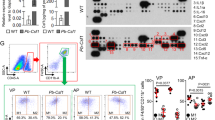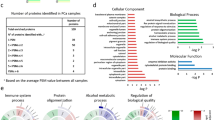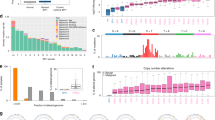Abstract
Prostate carcinoma is a hormonally driven age-related neoplasm. Cellular senescence is an age-related process where cells remain metabolically active but in a growth-arrested state at the G1 phase. p14ARF, p15INK4b, and p16INK4a, which are known to regulate G1 cell cycle arrest, and the tumor necrosis factor receptor superfamily member decoy receptor 2 (DCR2), have been recently identified as senescence markers. The purpose of this study was to characterize and compare the expression of p14ARF, p15INK4b, p16INK4a, and DCR2 in tissue microarrays containing cases of normal prostate, nodular hyperplasia, prostate intraepithelial neoplasia (PIN), and malignant prostate cancer tissue. We performed immunohistochemical staining for p14ARF, p15INK4b, p16INK4a, and DCR2 in tissue microarray blocks containing 41 cores of normal prostate, 65 cores of nodular hyperplasia, 21 cores of PIN, 69 cores of low-grade prostate carcinoma, and 42 cores of high-grade prostate carcinoma, derived from 80 cases of prostatectomy with adenocarcinomas. We detected positive staining of p16INK4a in 19% of the PIN, 25% of the low-grade carcinoma, and 43% of the high-grade carcinoma specimens but none in the normal prostate and nodular hyperplasia specimens. Expression of p14ARF revealed very high levels of expression in normal tissues (83%), nodular hyperplasia (88%), PIN (89%), and cancer cells (100%). P15INK4b and DCR2 were found positive in 81 and 33% normal, 46 and 10% nodular hyperplasia, 74 and 36% PIN tissues, 87 and 89% low-grade carcinomas, and 100 and 93% high-grade carcinomas. There is an increased protein expression of senescence-associated molecular markers, indicating that cellular senescence might play a role in prostate carcinoma. Because p16INK4a-positive cells were detected only in premalignant lesions and carcinomas but not in normal or benign tissues, p16INK4a may aid in the diagnosis of PIN and prostate cancer in difficult cases.
Similar content being viewed by others
Main
Accumulations of somatic mutations in older individuals contribute to the high frequency of prostate cancer occurrence. Increasing evidence shows that age-related changes affect the molecular crosstalk between stromal and epithelial cells generating a more permissive environment for tumor development.1 Cellular senescence is an age-related process and these cells accumulate in tissues with age. Senescent cells, originally defined in fibroblasts,2 remained metabolically active but in a growth-arrested state at the G1 phase.3 Senescence is an extremely stable form of cell cycle arrest that cells use to protect themselves from incidental oncogenic activation and may play a role as an antitumor mechanism because of its antiproliferative capacity. However, if certain tumor suppressor genes mutate, senescent cells may be immortalized and begin to over proliferate, which can lead to the development of cancer.
It is well established that pRb and p53 pathways play an important role in maintaining senescence,4 which are activated to promote senescence by products of the INK4a/ARF locus. The INK4a/ARF locus encodes three important tumor suppressors, p14ARF, p15INK4b, and p16INK4a. The p16INK4a gene, a cell cycle-related gene, encodes a p16 protein that binds competitively to cyclin-dependent kinase 4 protein5 and then, during the cell cycle G1 phase, inhibits the interaction of cyclin-dependent kinase 4 protein and cyclin D1 to stimulate passage through the cell cycle.6 The p16 protein is often highly expressed in senescent cells in culture and inactivated in a variety of human cancers.7 p14ARF shares a common exon 2 with the p16INK4a transcript but has a different exon 1b and is translated in an alternative reading frame.8, 9, 10 Loss of p14 in knockout mice also results in tumor formation.11 p15INK4b is located centromeric to the p16/p14 gene locus and encodes proteins that are known as major inhibitors of cell proliferation. It is a negative growth regulator and a downstream effector of transforming growth factor β-induced cell cycle arrest.12
Decoy receptor 2 (DCR2) is one of the tumor necrosis factor-related apoptosis-inducing ligand receptors; it suppresses tumor necrosis factor-related apoptosis-inducing ligand-induced apoptosis13 and is expressed in many normal tissues, but its expression is often silenced or downregulated by promoter hypermethylation in multiple cancer types, including cervical cancer, breast cancer, neuroblastoma, malignant mesothelioma, and prostate cancer.14
p14ARF, p15INK4b, p16INK4a, and DCR2 have been recently identified as senescence markers.15 The first three markers are important in G1 arrest and are often mutated or deleted in various malignancies and DCR2 can selectively induce apoptosis in cancer cells. Staining with antibodies against p14ARF, p15INK4b, p16INK4a, and DCR2 revealed abundant positive cells in premalignant lung tumors, whereas malignant tumors were essentially negative.15
The purpose of this study was to characterize and compare the expression of p14ARF, p15INK4b, p16INK4a, and DCR2 using immunoperoxidase technique in tissue microarrays containing cases of normal prostate, nodular hyperplasia, prostate intraepithelial neoplasia (PIN), and malignant prostate cancer tissue, and determine their expression in prostate cancer progression.
Materials and methods
Case Selection
The construction of the tissue microarray has been described previously16 which contains 41 cores of normal prostate tissue, 65 cores of nodular hyperplasia, 21 cores of PIN, 69 cores of low-grade prostate carcinoma (Gleason grade 2 and 3), and 42 cores of high-grade prostate carcinoma (Gleason grade 4 and 5) from 80 patients who had undergone prostatectomy at the University of Rochester Medical Center for the treatment of prostatic adenocarcinoma. All identifiers were removed to protect patient's confidentiality, the use of human tissue in the study was approved by the Institutional Review Board.
Immunohistochemical Staining
Tissue microarray slides were subjected to immunohistochemical staining. In brief, after initial deparaffinization, sections were steamed in 10 mM citrate buffer (pH 6.0) to unmask the epitopes for 20 min and then treated with protein-blocking solution (Biocare Medical, Walnut Creek, CA, USA) for 10 min. The slides were incubated against p16INK4a (Biocare Medical; 1:100 for 30 min at ambient temperature), p14ARF (GeneTex prediluted; 1 h at ambient temperature, San Antonio, TX, USA), p15INK4b (Santa Cruz; 1:300 for 1 h at ambient temperature, Santa Cruz, CA, USA), and DCR2 (Stressgen; 1:250 overnight at 4°C, San Diego, CA, USA). Slides were incubated with universal secondary antibody (Biocare Medical) and horseradish peroxidase (Biocare Medical) for 15 min each. Tissues were stained for 3 min with freshly prepared 3,3′-diaminobenzidine tetrahydrochloride and then counterstained with hematoxylin, dehydrated, and mounted.
Tissue Microarray Analysis
We visually read the array under the microscope, scoring each core individually. Cases in which no epithelial cells were found or no core was available were excluded from the study.
On the basis of expression patterns in prostate epithelial cells, p14ARF, p15INK4b, p16INK4a, and DCR2 protein expression was considered positive if any positive staining was seen in the epithelial cells. Immunostained tissue microarrays slides were semiquantitatively scored by two independent pathologists (ZZ and DR) blinded to the clinicopathologic information. Quantitation was performed using a four-score grading system. Negative was defined as the total absence of staining and given a score of ‘0’. Presence of staining was scored as weakly positive and given a score of ‘1’, intermediate positive score ‘2’, and strongly positive score ‘3’. For the statistical analysis, cases were grouped as negative (score ‘0’) or positive (score ‘1’, ‘2’, or ‘3’).
Statistical Analysis
The basic descriptive statistical analysis and tables were created using the Statistica software package, version 6.0 (Statsoft, Inc., Tulsa, OK, USA). Chi-square (χ2) test and Fisher's exact test were utilized for the analysis on categorical data. Results were considered statistically significant at the P<0.05 level.
Results
As shown in Figure 1, all instances of expression appeared in the cytoplasm of prostatic epithelial cells. p16INK4a analysis showed positive staining in 19% of the PIN, 25% of the low-grade carcinoma, and 43% of the high-grade carcinoma specimens but none in the normal prostate tissue and nodular hyperplasia specimens. The evaluation of expression of p14ARF revealed very high levels of expression in both the normal tissues (83%), nodular hyperplasia (88%), PIN (89%), and cancer cells (100%). P15INK4b and DCR2 were found positive in 81 and 33% of normal tissues, 46 and 10% in nodular hyperplasia tissues, 74 and 36% in PIN tissues, 87 and 89% in low-grade carcinomas, 100 and 93% in high-grade carcinomas (Table 1). A statistically significant difference was found among p14ARF, p15INK4b, p16INK4a, and DCR2 expression and pathologic lesions (Table 1). In all cases, the frequency of positive cores was significantly higher (P<0.05) in cancer tissues than in noncancer tissues, and there was a trend towards increased staining in high-grade prostate carcinomas (Gleason grade 4 and 5) compared with low-grade carcinomas (Gleason grade 2 and 3).
Expression of different markers in prostate tissues, as shown by positive or negative immunostaining of the cytoplasm. Normal tissue ( × 10): (a) p14, positive; (b) p15, negative; (c) p16, negative; and (d) DCR2, negative. Nodular hyperplasia ( × 10): (e) p14, positive; (f) p15, negative; (g) p16, negative; and (h) DCR2, negative. PIN ( × 10): (i) p14, positive; (j) p15, positive; (k) p16, positive; and (l) DCR2, positive. Low-grade prostate carcinoma ( × 40): (m) p14, positive; (n) p15, positive; (o) p16, positive; and (p) DCR2, negative. High-grade prostate carcinoma ( × 40): (q) p14, positive; (r) p15, positive; (s) p16, positive; and (t) DCR2, positive.
The results of immunostaining for p14ARF, p15INK4b, p16INK4a, and DCR2 in association with patients' pathologic lesions are summarized in Table 1.
Discussion
In this paper, we examined the expression of molecules implicated senescence pathway and found that p14ARF, p15INK4b, p16INK4a, and DCR2 were expressed more frequently in prostate carcinomas than in benign prostatic tissues, implying that p14ARF, p15INK4b, p16INK4a, and DCR2 are activated in prostate carcinoma. Meng et al17 found DCR2 overexpression in human colon cancer cells, and Liu et al13 found that some chemotherapy agents caused DCR2 overexpression in a human lung cancer cell line. Furthermore, Schwarze et al18 found that primary prostate tumors retain the ability to senesce in culture, and the p16/pRb pathway is altered in 85% of primary prostate cancers.19 These data suggest that cellular senescence may play a role in prostate cancer development.
In human cells, inactivation of p16INK4 also facilitates the immortalization process20 and p16INK4 activity increased in senescent cells21 but not in highly proliferative cells. Meanwhile, several investigators have found that overexpression of p14ARF and p16INK4 also plays a critical role in the growth arrest of normal epithelial cells associated with senescence.18, 19, 20, 22 Furthermore, senescent cells have been identified in human tissues, including nodular hyperplasia, a hyperproliferative disorder of the prostate.3 Several other studies have suggested that expression of p14ARF, p15INK4b, p16INK4a, and DCR2 is widely downregulated in several solid tumors including hepatic, pancreatic, esophageal, breast, and urinary bladder carcinomas and gliomas,6, 13, 23, 24 suggesting that senescence pathways are inactivated in large number of these tumors. Our data showed that p16INK4 and other markers have an increased expression during prostate tumor progression, suggesting that senescence pathways are still intact in large number of prostate cancers. Tumor and tissue heterogeneity may account for the contrast in expression between our results and those previously described by other studies.6, 13, 23, 24 This indicates that different types of tumor may have different mechanisms of inactivation of senescence program. The elucidation of these results may be matter of further investigation.
Most studies have used normal diploid fibroblasts as a model to study senescence.18 However, most cancers originate from epithelial cells,25 including prostate cancers. Recently, other cell types have been shown to demonstrate senescent activity in culture, such as lung epithelial,15 hepatic,6 and pancreatic cells.26 To our knowledge, our study is the first to determine the expression of senescence markers p14ARF, p15INK4b, p16INK4a, and DCR2 in cells of human prostate tissue samples. Our data, involving the staining of normal tissue, nodular hyperplasia, PIN, and prostate carcinoma specimens for senescence markers, showed that these biomarkers were differentially expressed during prostatic cancer progression.
In summary, our study demonstrated that there is an increased protein expression of senescence-associated molecular markers indicating that cellular senescence might play a role in prostate cancer progression. In addition, p16INK4a staining might be a diagnostic aid particularly in prostate carcinomas and intraepithelial neoplasias for difficult cases.
References
Kim HJ, Jung KJ, Yu BP, et al. Modulation of redox-sensitive transcription factors by calorie restriction during aging. Mech Ageing Dev 2002;123:1589–1595.
Hayflick L, Moorhead PS . The serial cultivation of human diploid cell strains. Exp Cell Res 1961;25:585–621.
Choi J, Shendrik I, Peacocke M, et al. Expression of senescence-associated beta-galactosidase in enlarged prostates from men with benign prostatic hyperplasia. Urology 2000;56:160–166.
Incles CM, Schultes CM, Kempski H, et al. A G-quadruplex telomere targeting agent produces p16-associated senescence and chromosomal fusions in human prostate cancer cells. Mol Cancer Ther 2004;3:1201–1206.
Sherr CJ . Cancer cell cycles. Science 1996;274:1672–1677.
Jin M, Piao Z, Kim NG, et al. p16 is a major inactivation target in hepatocellular carcinoma. Cancer 2000;89:60–68.
Michaloglou C, Vredeveld LC, Soengas MS, et al. BRAFE600-associated senescence-like cell cycle arrest of human naevi. Nature 2005;436:720–724.
Haber DA . Splicing into senescence: the curious case of p16 and p19ARF. Cell 1997;91:555–558.
Nguyen TT, Nguyen CT, Gonzales FA, et al. Analysis of cyclin-dependent kinase inhibitor expression and methylation patterns in human prostate cancers. Prostate 2000;43:233–242.
Quelle DE, Zindy F, Ashmun RA, et al. Alternative reading frames of the INK4a tumor suppressor gene encode two unrelated proteins capable of inducing cell cycle arrest. Cell 1995;83:993–1000.
Kamijo T, Zindy F, Roussel MF, et al. Tumor suppression at the mouse INK4a locus mediated by the alternative reading frame product p19ARF. Cell 1997;91:649–659.
Hannon GJ, Beach D . p15INK4B is a potential effector of TGF-beta-induced cell cycle arrest. Nature 1994;371:257–261.
Liu X, Yue P, Khuri FR, et al. Decoy receptor 2 (DcR2) is a p53 target gene and regulates chemosensitivity. Cancer Res 2005;65:9169–9175.
Shivapurkar N, Toyooka S, Toyooka KO, et al. Aberrant methylation of trail decoy receptor genes is frequent in multiple tumor types. Int J Cancer 2004;109:786–792.
Collado M, Gil J, Efeyan A, et al. Tumour biology: senescence in premalignant tumours. Nature 2005;436:642.
Huang J, Yao JL, Zhang L, et al. Differential expression of interleukin-8 and its receptors in the neuroendocrine and non-neuroendocrine compartments of prostate cancer. Am J Pathol 2005;166:1807–1815.
Meng RD, McDonald III ER, Sheikh MS, et al. The TRAIL decoy receptor TRUNDD (DcR2, TRAIL-R4) is induced by adenovirus-p53 overexpression and can delay TRAIL-, p53-, and KILLER/DR5-dependent colon cancer apoptosis. Mol Ther 2000;1:130–144.
Schwarze SR, Shi Y, Fu VX, et al. Role of cyclin-dependent kinase inhibitors in the growth arrest at senescence in human prostate epithelial and uroepithelial cells. Oncogene 2001;20:8184–8192.
Jarrard DF, Sarkar S, Shi Y, et al. p16/pRb pathway alterations are required for bypassing senescence in human prostate epithelial cells. Cancer Res 1999;59:2957–2964.
Reznikoff CA, Yeager TR, Belair CD, et al. Elevated p16 at senescence and loss of p16 at immortalization in human papillomavirus 16 E6, but not E7, transformed human uroepithelial cells. Cancer Res 1996;56:2886–2890.
Hara E, Smith R, Parry D, et al. Regulation of p16CDKN2 expression and its implications for cell immortalization and senescence. Mol Cell Biol 1996;16:859–867.
Sandhu C, Donovan J, Bhattacharya N, et al. Reduction of Cdc25A contributes to cyclin E1-Cdk2 inhibition at senescence in human mammary epithelial cells. Oncogene 2000;19:5314–5323.
Ashkenazi A, Dixit VM . Death receptors: signaling and modulation. Science 1998;281:1305–1308.
Kelley SK, Ashkenazi A . Targeting death receptors in cancer with Apo2L/TRAIL. Curr Opin Pharmacol 2004;4:333–339.
Greenlee RT, Hill-Harmon MB, Murray T, et al. Cancer statistics, 2001. CA Cancer J Clin 2001;51:15–36.
Chen F, Li Y, Lu Z, et al. Adenovirus-mediated Ink4a/ARF gene transfer significantly suppressed the growth of pancreatic carcinoma cells. Cancer Biol Ther 2005;4:1348–1354.
Author information
Authors and Affiliations
Corresponding authors
Rights and permissions
About this article
Cite this article
Zhang, Z., Rosen, D., Yao, J. et al. Expression of p14ARF, p15INK4b, p16INK4a, and DCR2 increases during prostate cancer progression. Mod Pathol 19, 1339–1343 (2006). https://doi.org/10.1038/modpathol.3800655
Received:
Revised:
Accepted:
Published:
Issue Date:
DOI: https://doi.org/10.1038/modpathol.3800655
Keywords
This article is cited by
-
Increased mRNA expression of CDKN2A is a transcriptomic marker of clinically aggressive meningiomas
Acta Neuropathologica (2023)
-
Cellular senescence as a possible link between prostate diseases of the ageing male
Nature Reviews Urology (2021)
-
Protein arginine methylation: an emerging regulator of the cell cycle
Cell Division (2018)
-
Senescent cells: an emerging target for diseases of ageing
Nature Reviews Drug Discovery (2017)
-
FOXA2 is a sensitive and specific marker for small cell neuroendocrine carcinoma of the prostate
Modern Pathology (2017)




